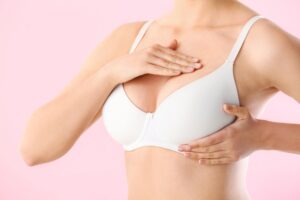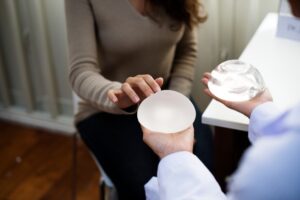What Do Beautiful Breasts Look Like?
Written By Joe Gryskiewicz, MD, FACS
Breast shape and size vary greatly from woman to woman, and what is considered beautiful can also differ based on cultural and personal preferences. Beauty standards for breasts have evolved over time. For example, in the 1950s, the ideal breast shape was more pointed and conical, while in the 1990s, a more round and full shape was preferred. However, there is some common ground when it comes to what beautiful breasts look like for most people.
As a plastic surgeon, I’ve seen many patients who are unhappy with the appearance of their breasts and want to know what they can do to improve them. In this blog post, we’ll explore what makes breasts beautiful and the different factors that can influence their appearance, including breast shape, size, symmetry, nipple position, and more. Whether you’re considering breast surgery or simply curious about what constitutes beautiful breasts, this post is for you. So let’s dive in and take a closer look at this fascinating topic.
Minnesota plastic surgeon, Dr. Joe Gryskiewicz, routinely performs breast procedures to help patients achieve their aesthetic goals. Dr. Joe takes a personalized approach to each of his patients, taking the time to understand their goals and concerns in order to develop a customized treatment plan.
What Features Define The Breasts?
Breasts are a complex part of the female anatomy, and there are several features that define them. Here are some of the most important features of the breasts:
- Size: Breasts come in all shapes and sizes, and the size of a woman’s breasts is determined by a number of factors, including genetics, body weight, and hormonal changes.
- Shape: Breast shape can also vary greatly, with some women having more rounded, full breasts, and others having breasts that are more conical or teardrop-shaped. Breast shape can also change over time, particularly after pregnancy and breastfeeding.
- Nipple position: The position of the nipples on the breast can also vary, with some women having nipples that point slightly upwards and others having nipples that point downwards. The position of the nipples can also change over time, with age.
- Skin texture: The texture of the skin on the breast can also affect their appearance. Smooth, supple skin is often seen as more attractive than rough or uneven skin.
- Symmetry: Breasts can also differ in size and shape between the left and right sides of the body. While some asymmetry is normal, significant differences can be a source of concern for some women.
- Areola size and color: The size and color of the areola, the darker area surrounding the nipple, can also vary greatly between women.
These features all contribute to the overall appearance of the breasts, and can be important considerations for women who are considering breast surgery.
Types of Breasts
 Breasts come in many different shapes and sizes, and there is no one correct or perfect type of breast. Among the most common types of breasts we can mention:
Breasts come in many different shapes and sizes, and there is no one correct or perfect type of breast. Among the most common types of breasts we can mention:
- Round breasts:These breasts are generally fuller and round in shape, with a gentle slope and a slight bulge at the top.
- Teardrop breasts: These breasts are similar to round breasts, but with a slightly pointed shape, resembling a teardrop.
- Asymmetrical breasts: Many women have breasts that are different sizes or shapes, with one breast being larger or fuller than the other.
- East-West breasts: These breasts are farther apart, with nipples pointing outward in opposite directions.
- Side set breasts: These breasts are similar to east-west breasts, but with a narrower gap between them.
- Slender breasts: These breasts are thinner and less full, with a more elongated shape.
- Athletic breasts: These breasts are flatter and more muscular, often found in women who are highly active or involved in sports.
It’s worth noting that breast shape and size can change over time due to factors such as weight gain or loss, pregnancy, and aging.
Big Breasts vs Small Breasts – How Important Is the Size?
The beauty of breasts is subjective and depends on cultural and personal preferences, like we mentioned before. Some people may find larger breasts more attractive, while others may prefer smaller breasts. Ultimately, the beauty of breasts should not be measured by size alone. Other factors such as breast symmetry, shape, and nipple position are also important considerations.
Some benefits of larger breasts are:
- Can enhance a woman’s curves and create an hourglass figure;
- May boost a woman’s self-confidence and self-esteem;
- Can be a source of sexual attraction and pleasure for some individuals;
- Can provide more cleavage and options for fashion choices.
The disadvantages of having larger breasts are:
- May cause discomfort, pain, and back problems, especially for women who are overweight or have a larger bust;
- May make it more challenging to engage in physical activities such as running, jumping, or playing sports;
- May be more prone to sagging and stretch marks;
- Can draw unwanted attention and unwanted sexual advances from others.
Some benefits of smaller breasts are:
- Can be more comfortable and less likely to cause back pain or discomfort;
- Can be easier to find clothes that fit well;
- Easier to jog and participate in sports
Some disadvantages of smaller breasts are:
- May cause some women to feel self-conscious or less feminine;
- May limit a woman’s ability to fill out certain clothing styles or swimsuits;
- May result in a negative self-image or low self-esteem for some women.
The Importance of Fullness and Proportion for Beautiful Breasts
While breast size and shape are largely determined by genetics, the fullness and proportion of the breasts can greatly impact their overall aesthetic appeal.
Fullness, or the degree to which the breasts are round and plump, is often seen as an important aspect of breast beauty. Women with fuller breasts tend to be perceived as more attractive and feminine, as fullness is often associated with youthfulness and fertility. This is one reason why many women seek out breast augmentation surgery, to restore or enhance fullness that has been lost due to weight loss, pregnancy, or aging.
Proportion is also crucial when it comes to breast beauty. Ideally, the breasts should be in proportion with the rest of the body, with the nipples pointing forward and the cleavage area defined but not exaggerated. Breasts that are too small or too large in proportion to the rest of the body can appear unbalanced or disproportionate, which may detract from their overall attractiveness. This is why breast augmentation surgeries often strive for a natural and proportionate appearance.
What Can Make the Breasts Less Beautiful?
While there are many aspects of breasts that are considered desirable, there are also some aspects that are generally considered less desired. Here are a few:
- Sagging:Breasts that sag or droop due to aging, weight loss, or pregnancy are often seen as less attractive. This is because sagging can make the breasts appear less firm and youthful.
- Asymmetry: Breasts that are noticeably different in size or shape can be seen as less attractive. While it is common for breasts to have some degree of asymmetry, significant differences can be a source of dissatisfaction for some women. Remember, think of your breasts as sisters, not twins.
- Stretch marks: Stretch marks on the breasts, which can occur due to weight gain or pregnancy, are often seen as less desirable. While they are a natural part of the body’s response to growth, some women may feel self-conscious about their appearance.
- Scarring: Scars on the breasts, whether from surgery or injury, can be a source of dissatisfaction for some women. While scarring is a natural part of the healing process, it can be a visible reminder of past trauma or surgery.
- Excessive hair growth: While hair around the nipples is normal, excessive hair growth on the breasts can be seen as an aesthetic issue. This is because it can be perceived as unattractive or unhygienic.
Non-Surgical Solutions to Enhance the Beauty of the Breasts

- Proper bra fitting: Wearing a bra that fits properly can make a significant difference in the appearance of the breasts. A well-fitting bra can provide support, lift, and enhance the shape of the breasts.
- Exercise: Strength-training exercises that target the chest muscles, such as push-ups or chest presses, can help to enhance the appearance of the breasts. These exercises can increase muscle tone and lift the breasts, giving them a more youthful appearance;
- Good posture: Maintaining good posture can help to improve the appearance of the breasts. Standing up straight with the shoulders back and chest lifted can make the breasts appear more lifted and perky;
- Skincare: Moisturizing the skin on the breasts can help to improve their appearance. Applying a moisturizer or oil to the breasts regularly can help to keep the skin hydrated, firm, and supple;
- Clothing choices: Choosing clothing that flatters the shape and size of the breasts can also enhance their appearance. For example, wearing tops with a V-neckline can help to elongate the neck and make the breasts appear more lifted. Wearing a properly fitting bra under clothing can also create a smoother, more flattering silhouette.
Surgical Solutions to Get Beautiful Breasts
 Breast surgery can be an effective way to enhance the appearance of the breasts. However, not all procedures are suitable for everyone. Here is a breakdown of the surgical solutions available to get beautiful breasts and who may be good candidates for each procedure:
Breast surgery can be an effective way to enhance the appearance of the breasts. However, not all procedures are suitable for everyone. Here is a breakdown of the surgical solutions available to get beautiful breasts and who may be good candidates for each procedure:
- Breast Augmentation
This procedure is designed to enhance the size and shape of the breasts using implants. Good candidates for breast augmentation are women who have small or asymmetrical breasts, or who have lost volume due to weight loss or pregnancy. Candidates should be in good overall health, have realistic expectations for the outcome, and be willing to follow post-operative care instructions. - Breast Lift
This procedure is designed to lift and reshape sagging breasts, giving them a more youthful appearance. Good candidates for breast lift surgery are women who have lost volume and elasticity due to pregnancy, breastfeeding, or weight loss, and whose nipples have begun to sag. You can put a card or a piece of paper in your breast fold, and if the nipple is below the edge of the cards, you may need a breast lift.
- Breast Reduction
This procedure is designed to remove excess breast tissue and skin, reducing the size and weight of the breasts. Good candidates for breast reduction surgery are women who experience physical discomfort, such as back or neck pain, due to the size of their breasts.
- Breast Reconstruction
This procedure is designed to rebuild the breast after a mastectomy or other breast surgery. Good candidates for breast reconstruction are women who have undergone a mastectomy and are interested in restoring the appearance of their breasts.
It is important to note that each patient is unique and the best surgical solution will depend on the individual’s specific goals and anatomy. A consultation with a board-certified plastic surgeon can help determine which procedure is most appropriate for a particular patient.
Further Reading about Breast Procedures with Dr. Joe
- Read Dr Joe’s Quick Recovery® breast augmentation
- Read Dr Joe’s Breast augmentation with a lift
- Read Dr Joe’s Breast lift surgery
- Read Dr Joe’s blog about How Can I Enlarge My Breasts? – Breast Enlargement Surgeries
- Visit our Breast Augmentation Gallery



